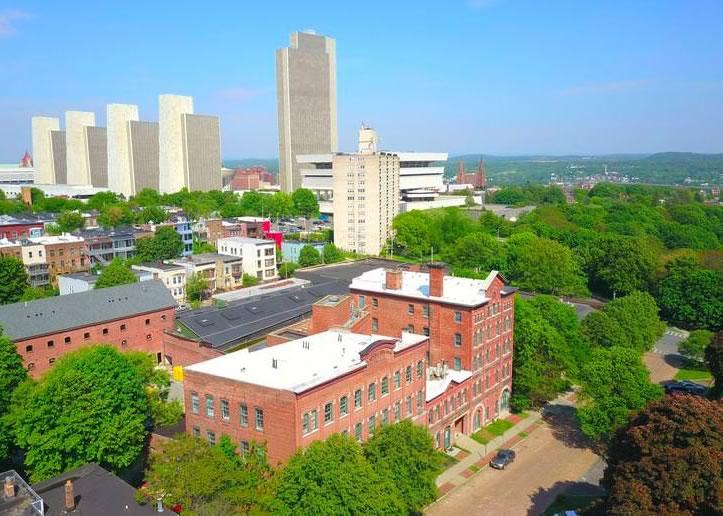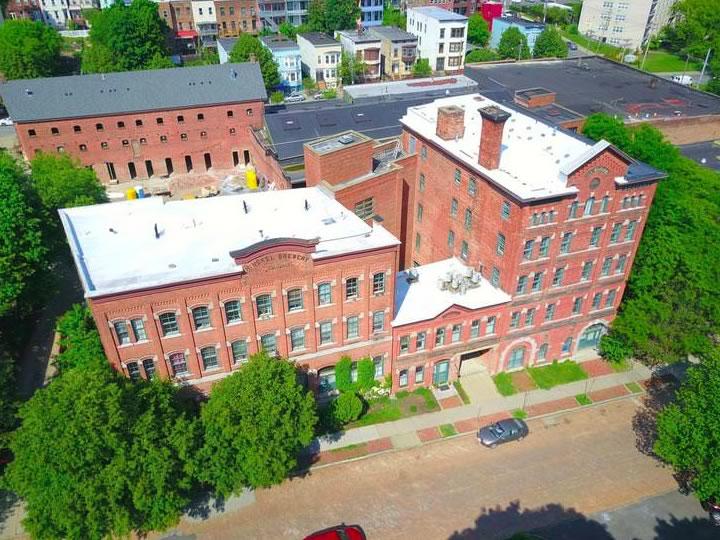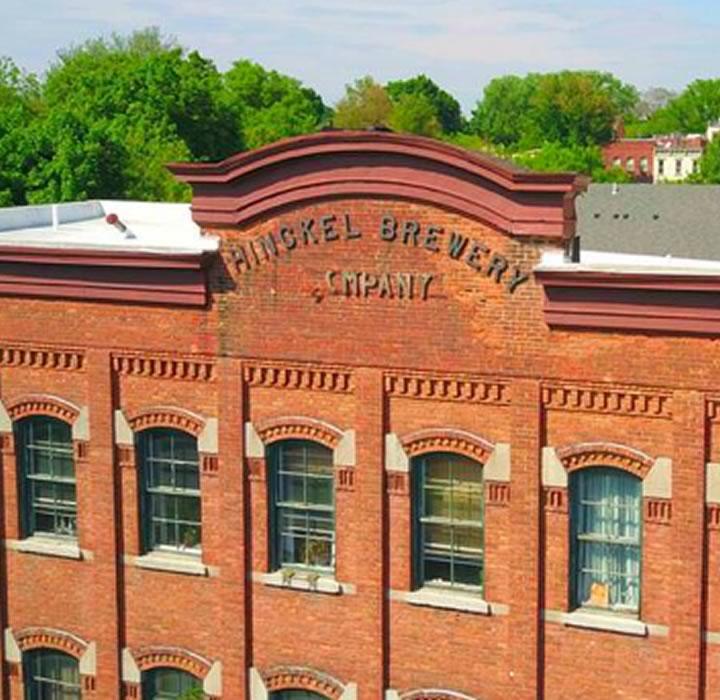Frederick Hinckel and the Hinckel Brewery

The Hinckel Brewery building with the Empire State Plaza in the background. / photo: Tim Jackson
On the northwest corner of Park Avenue and South Swan Street in Albany's Hudson/Park neighborhood, a multi-building complex takes up almost half a city block and dominates the immediate area. Constructed in the late 1880s, this behemoth played a vital role in the brewing and distribution of beer across the city and the country.
This is the story of immigrant, brewmaster, and former Albany resident Frederick Hinckel -- and the Hinckel Brewery.
Coming to America
Frederick Hinckel was born October 29, 1832 in Prussia (present day Germany) to a working class family. From an early age, the odds were stacked against him. A biography on Hinckel that appeared in the Bi-centennial History of Albany said: "He began the battle of existence as a poor boy, but he set before his feet the resolve that to waste no opportunity that might help him along the pathway to success," and that in his youth he "passed through a rugged experience which while bringing, mayhap, a volume of denials and struggling efforts, surely established the sense of self-reliance and determined energy that worked out the successful purposes of his later life."
This "can do" attitude led to Hinckel emigrating to the United States with dreams of making a better life for himself. Together with Johann Andreas Schinnerer, a Bavarian immigrant to the United States, he opened up the Cataract Brewery in Albany in 1852. The name "cataract" is a reference to Buttermilk Falls of Beaver Creek that was once nearby, where the Lincoln Park ravine is presently located.
Slowly but surely this fledgling brewery founded by immigrants began producing beer for consumption by consumers in Albany and beyond. In its early years, the brewery reportedly produced 500 barrels of beer per year, a small output. Its products included Hinckel's Sparkling Lager, which was popular with its customers and was sold throughout the brewery's existence, as well as Sparkling Pure Malt.

photo: Tim Jackson
Expansion and modernization
By the early 1860s, Hinckel bought out his business partner and renamed the Cataract Brewery as the Hinckel Brewery. With the brewery firmly in his control, Hinckel looked toward scaling up the operation in order to compete with other breweries in the Albany such as the Dobler Brewing Company, located around the corner from Hinckel at the corner of Swan and Myrtle, the Armsdell Brewery on Jay Street, the Hedrick Brewery located on Central Avenue in between Ontario and Partridge, and John Taylor & Sons located at 133 Broadway, just to name a few.
After taking over the brewery and continuing into the early 1880s, Hinckel expanded the original brewery building into the five-building complex that exists today. More space for brewing alcoholic beverages meant Hinckel needed to hire more workers and he would bring on between sixty and seventy-five employees over the next two decades.
The investment made by Hinckel didn't just include adding more employees, but also modernizing his brewery. In the July 28, 1889 issue of the Albany Sunday Express, the paper published an article under its "Albany's Industries" section that highlighted the end result of Hinckel's efforts to modernize, among them the latest developments in artificial refrigeration. (The Albany Sunday Express claimed that artificial refrigeration "is one of the greatest achievements in modern science." )
The Hinckel Brewery was the only brewery in Albany to use such a refrigeration system at the time. To power this massive refrigeration system, the brewery used a 200-horsepower compound condensing engine, standing at twenty feet in height and reportedly weighing fifty tons. The article also mentions that "miles of piping" were needed throughout the brewery as well as several large, 350-horsepower steam boilers.
The brewery also had its own Edison incandescent system made up of two hundred light bulbs, which the paper said "brilliantly illuminated" the brewery's underground rock vaults and passages.
The expansion and upgrades allowed Hinckel to significantly increase production. A few years earlier in 1886, the Hinckel Brewery reportedly produced more than 35,000 barrels of beer in a year.

photo: Tim Jackson
Sadly, Hinckel was not alive to see the completion of the modernization and expansion of his brewery. The October 30, 1881 edition of the Albany Times reported that Hinckel had died the day before at his home at the corner of Elm and South Swan Street, located just three blocks north of the brewery complex.
Hinckel was survived by his wife, Helena, and their four children, two of whom (Frederick Jr. and Charles) worked with Hinckel at the brewery for several years before his death. Hinckel is buried in Albany Rural Cemetery.
With their father gone, it was time Frederick Jr. and Charles to take over the brewery, however, it was not without its bumps in the road.
A beer war, court cases, Prohibition, and today
Hinckel's sons managed the brewery in the years following their father's death and continued his legacy in the brewing industry. While the brewery established itself in Albany, Frederick Jr. and Charles sought to expand their reach and tap into new markets. One potential market was Boston, Massachusetts -- much to the anger Boston's breweries.
In 1899 the Bostonian brewers accused the Hinckel Brewery for allegedly "cutting prices [of their beer] below the profit making point." The Hinckels denied the accusation and said that their beer was selling on its merits, which led the Bostonians to threaten a "beer war" with Albany breweries unless the Hinckel Brewery "loosened their grip" over distributing their product in Boston. In response, the other Albany breweries collectively sided with the Hinckels and reportedly "did not seem very afraid" of a possible beer war with Boston.
In addition to the threat of an interstate beer war, the Hinckel Brewery also experienced the collapse of a 128-foot smoke stack that year. The Saturday, August 20th, 1899 issue of The Times-Union reported that at 6 pm that day when workers were getting ready to leave one of the supports of the giant smoke stack "gave way and the mass of iron fell," striking one of the brewery's buildings and "crushing it like an egg shell."

In 1902 the Hinckels found themselves faced with mounting financial pressure reportedly caused by "recent consolidation of banks in this city" and assigned their brewery to Edward Murphy of Troy. (An assignment can be viewed simply as the transfer of property from one person to another.) Reportedly the brewery was worth $1 million (roughly $28 million in today's dollars) when Murphy took control in his capacity as a receiver of the company.
This commenced several years of legal action over the brewery, which included allegations of misconduct against Murphy, a bankruptcy trial that included testimony by Charles Hinckel, a public auction which resulted in Charles Hinckel's close friend Fred Ullman -- the chairman of the executive committee of the American Malting Company -- purchasing the brewery for $280,000. Ullman then put Hinckel back in charge of the brewery his father started.
The brewery continued to produce beer for almost two more decades until Prohibition, which like most breweries across the country, was a death blow. The Hinckel Brewery shut its doors in 1922.
Today, the Hinckel Brewery now serves as an apartment building, owned by Hinckel Brewery LLC, according to city records and is valued for property tax purposes at $1.9 million dollars.
Justin Devendorf is a resident of the Pine Hills neighborhood of Albany. He currently goes to Albany Law School and created the Photozofalbany Instagram page, where he shares the history and beauty of New York State's capital city and the surrounding region one post at a time.
Say Something!
We'd really like you to take part in the conversation here at All Over Albany. But we do have a few rules here. Don't worry, they're easy. The first: be kind. The second: treat everyone else with the same respect you'd like to see in return. Cool? Great, post away. Comments are moderated so it might take a little while for your comment to show up. Thanks for being patient.
Comments
Very nice write-up!
As a note after Prohibition, Dobler brewery (one of the three breweries in Albany to survive prohibition) located just across Swan Street, purchased the defunct Hinckel, and expanded its operations, and continued to use the brewery until closing in 1959.
... said Craig on Jun 6, 2018 at 4:07 PM | link
Thank you Craig! Appreciate you reading it. Good to know about the Dobler brewery, I wonder how they and the other two Albany breweries that survived Prohibition got so lucky??
... said Justin Devendorf on Jun 6, 2018 at 4:32 PM | link
Oh! And in regards to the "Beer War", Hinckel was one of Albany's last "widely" (and I use widely loosely, here, compared to earlier Albany breweries) distributed breweries. In the late 19th century Hinckel had bottling contracts in both Manchester, New Hampshire and Boston.
Also, if you really want to read something gross, check out what the Documents of the Senate of the State of New York, Volume 6, 5th Annual Report of the State Board of Health of New York, says about the area around Hinckel and Martinsville. Here's blurb...
"From Hinckel’s large brewery a torrent of sewage is poured down the ravine and enters the sewer just west of Swan street; this sewage is, in part, derived from the hollow lying just north of the brewery, which, taken alone, is a nuisance of the first magnitude. In this hollow, which extends from above Dove street about half way to Swan street, a quantity of sewage is exposed in shallow pools, giving forth a horrible stench. East of Swan street the Park avenue sewer discharges the sewage of over 100 houses down the rocky termination of the ravine, while the waste-water from Dobler's brewery has eroded a channel near by in the clayey soil over which it flows."
... said Craig on Jun 6, 2018 at 5:19 PM | link
Justin, maybe a bit more than luck—at least for two of them. Beverwyck was big, the biggest in the region, in fact. If any brewery was going to reopen after repeal, it was going to be them.
Dobler had been purchased by the Feigenspan family—owners of a large brewery in Newark, NJ, just before prohibition (1916ish). They actually closed brewing operations in New Jersey, and focused on ice production, but kept Dobler up and running making near-beer during the dark years. After repeal Dobler got back up and running pretty quickly.
By most accounts Hedrick should have shuttered even before Prohibition, but when it was acquired by an associate of Dan O'Connell's (too long of a story to explain here), the brewery's fortune changed.
... said Craig on Jun 6, 2018 at 9:28 PM | link
correction - Prussia is not modern day Germany. It no longer exists and was split into multiple countries after the Treaty of Versailles.
... said Steve T on Jun 7, 2018 at 8:17 AM | link
@Steve T: He's referring to the fact that Hinckel was from a part of Prussia that is now in Germany.
... said Greg on Jun 7, 2018 at 9:31 AM | link
Justin -- Thanks for (another) fab write-up.
I believe that Buttermilk Falls took it's name from the fragrant melange of sewage and brewing effluent, which caused the Beaver Creek falls to froth 'like buttermilk'. (My source for this is the Lincoln Park Wiki article, which everyone should read. It references a 1993 Paul Grondahl article that I cannot access, alas.)
... said Ian Benjamin on Jun 7, 2018 at 11:29 AM | link
@Craig Alas, we still haven't fixed the raw sewage issue. When that combined sewer trunk line (Albany Water calls it the Big C, iirc) was constructed, two surface discharge outlets were installed. They're still there. When the combined sewer reaches capacity after heavy rains or snowmelt, raw sewage is occasionally discharged into the ravine. If you live in the neighborhood, you know exactly when this happens. cause you can smell it. Especially in the summer. This is one of the reasons the City is desperate to build a new trunk line and sewer filtration system near that hollow. There's also the sinkhole issue.
And, out of curiosity, what waste would these breweries have been producing? Do modern brewing processes produce this waste as well?
... said Ian Benjamin on Jun 7, 2018 at 11:30 AM | link
I'd expect much of the waste was plant matter- the grain mash and hop blossoms, plus the spent yeasts - this was skimmed off the top of the vats or left behind when they were emptied. In the 19th C. pigs and cows kept in cities were fed the swill- and led brief miserable existences.
... said Eric Scheirer Stott on Jun 7, 2018 at 3:06 PM | link
Thank you for informative write-up. I lived near by at 175 South Swan Street Executive House when it was first constructed. I was student at Albany State at time and then moved out to join TWA airlines. I never knew any of this history and wondered why Hinckel came direct to Albany from Germany and how he financially was able to start this company. I haven’t been back to Albany for years but one to get up there soon to see how it has changed and to appreciate that which I did not as a young girl growing up on Morton Ave and 175 South Swan Street
... said Rosemary Marchitell on Jun 9, 2018 at 1:48 AM | link
Excellent article.
But you forgot the part about the subterranean tunnel stretching from the brewery cellar all the way to the Port of
Albany, complete with train tracks. It was used by fugitive slaves as part of the Underground Railroad.
Just kidding, of course. But someone recently swore that was actually the case.
... said Paula on Jun 11, 2018 at 10:46 AM | link
Rosemary, I appreciate you reading the article, thank you so much!
Paula, thank you very much! And lol about the underground railroad!
... said Justin Devendorf on Jun 12, 2018 at 10:47 PM | link